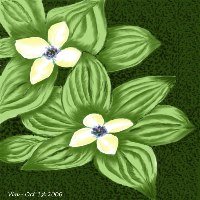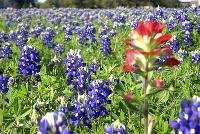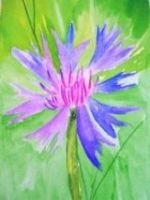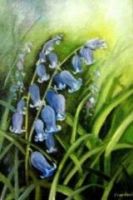B
Here are the entries for the second round of the Flower Festival:
 Bunchberry (Sent in by Vin of http://www.avlokana.com/ ) : BunchBerry is kind of a wild flower, the plant grows slowly but requires little care. The bunchberry flower is a small flower that has four petals and is mostly white in color. The beauty apparently comes for its placement over its green leaves creating a contrast.
Bunchberry (Sent in by Vin of http://www.avlokana.com/ ) : BunchBerry is kind of a wild flower, the plant grows slowly but requires little care. The bunchberry flower is a small flower that has four petals and is mostly white in color. The beauty apparently comes for its placement over its green leaves creating a contrast. Butterfly Bush (Sent in by Ginian of http://giniann.wordpress.com/) : The butterfly bush is usually pruned in late winter. In the spring, they start growing back and grow to large sizes by summer. Almost always, you can find butterflies and bees gathering around this bush. Doesn’t need any special care, other than pruning them in winter.
Butterfly Bush (Sent in by Ginian of http://giniann.wordpress.com/) : The butterfly bush is usually pruned in late winter. In the spring, they start growing back and grow to large sizes by summer. Almost always, you can find butterflies and bees gathering around this bush. Doesn’t need any special care, other than pruning them in winter.
 Blue Bonnets (Sent in by Hema of http://vegconcoctions.wordpress.com/) : Blue bonnets start blooming in early spring and blankets of these wild flowers can be seen throughout central and south Texas from late March to early May. It is named for its blue color and the resemblence of its petals to a woman’s sunbonnet (worn as head coverings during the 18th century). They typically grow about 1 feet tall.
Blue Bonnets (Sent in by Hema of http://vegconcoctions.wordpress.com/) : Blue bonnets start blooming in early spring and blankets of these wild flowers can be seen throughout central and south Texas from late March to early May. It is named for its blue color and the resemblence of its petals to a woman’s sunbonnet (worn as head coverings during the 18th century). They typically grow about 1 feet tall.
 Bird of Paradise (Sent in by Paavani of http://www.paavani.in/blog/) : The name Bird of Paradise comes from the spectacular flower shape, which resembles a bird’s beak and head plumage. They have banana shaped leaves and that’s why it was classified in the banana family Musaceae, but now got own family Strelitziacea. You will be amazed if you see how its blooms. Long stemmed flowers emerge from green boat-shaped bracts, which are bordered in red or purple. The numerous pointed petals of brilliant orange are contrasted with an arrow-shaped tongue of vivid blue. Some species have white and blue. The flowers have several “sets” of flowers in each bract, which are formed on the end of a stalk.
Bird of Paradise (Sent in by Paavani of http://www.paavani.in/blog/) : The name Bird of Paradise comes from the spectacular flower shape, which resembles a bird’s beak and head plumage. They have banana shaped leaves and that’s why it was classified in the banana family Musaceae, but now got own family Strelitziacea. You will be amazed if you see how its blooms. Long stemmed flowers emerge from green boat-shaped bracts, which are bordered in red or purple. The numerous pointed petals of brilliant orange are contrasted with an arrow-shaped tongue of vivid blue. Some species have white and blue. The flowers have several “sets” of flowers in each bract, which are formed on the end of a stalk.
 Buttercups (Sent in by Anita of http://madteaparty.wordpress.com/) : Buttercups are usually yellow but sometimes, also white. Most buttercups have five to six petals, and numerous spirally arranged stamens surrounding the green center. After pollination this green part which is a number of distinct tapering pistils, will develop into a small dry fruit, the achenes. True to the genus, the leaves are deeply tri-lobed.Buttercups get their name from a small cup-like feature, called the nectariferous spot, at the base of the petals that keeps nectar for the pollinating insects; their treat for helping out! Anita has a series of beautiful pictures of Buttercups in her blog. Do check out her blog.
Buttercups (Sent in by Anita of http://madteaparty.wordpress.com/) : Buttercups are usually yellow but sometimes, also white. Most buttercups have five to six petals, and numerous spirally arranged stamens surrounding the green center. After pollination this green part which is a number of distinct tapering pistils, will develop into a small dry fruit, the achenes. True to the genus, the leaves are deeply tri-lobed.Buttercups get their name from a small cup-like feature, called the nectariferous spot, at the base of the petals that keeps nectar for the pollinating insects; their treat for helping out! Anita has a series of beautiful pictures of Buttercups in her blog. Do check out her blog.
 Bachelor's Button (Sent in by Priya of http://fromnaturetome.blogspot.com/) : a.k.a Cornflower grows wildly in the fields of Europe. They bloom with little care and are a favorite with gardners. These bright blue blooms appear from summer to early fall. It was declared a national emblem of unity in Germany. These plants generally grow to a height of 1-3 feet and are easy to maintain in dry flower arrangements cause they retain their colour well. They attract a lot of butterflies, bees and birds.
Bachelor's Button (Sent in by Priya of http://fromnaturetome.blogspot.com/) : a.k.a Cornflower grows wildly in the fields of Europe. They bloom with little care and are a favorite with gardners. These bright blue blooms appear from summer to early fall. It was declared a national emblem of unity in Germany. These plants generally grow to a height of 1-3 feet and are easy to maintain in dry flower arrangements cause they retain their colour well. They attract a lot of butterflies, bees and birds.
 Bluebells (Sent in by Sree of http://sreescanvas.blogspot.com/) : Also called Wild Hyacinth ( quite a striking resemblance to the water hyacinth both in color and form). Sree quotes from a description of these blue beauties - The bluebell, popularly thought of as Britain's national flower, is a bulbous spring flowering plant. When growing en masse in woodlands it creates a dazzling display of brilliant blue, which is not only a great wild flower phenomenon, but also a British speciality. The fragrant bell-shaped flowers stand upright when they are in bud, but hang downwards, nodding in the breeze when fully open; they may be violet-blue, white or even pink on rare occasions, and have cream-coloured anthers. They are arranged in clusters of 4-16 on flower spikes (known as racemes), which have drooping tips.
Bluebells (Sent in by Sree of http://sreescanvas.blogspot.com/) : Also called Wild Hyacinth ( quite a striking resemblance to the water hyacinth both in color and form). Sree quotes from a description of these blue beauties - The bluebell, popularly thought of as Britain's national flower, is a bulbous spring flowering plant. When growing en masse in woodlands it creates a dazzling display of brilliant blue, which is not only a great wild flower phenomenon, but also a British speciality. The fragrant bell-shaped flowers stand upright when they are in bud, but hang downwards, nodding in the breeze when fully open; they may be violet-blue, white or even pink on rare occasions, and have cream-coloured anthers. They are arranged in clusters of 4-16 on flower spikes (known as racemes), which have drooping tips.

Buffalo Bur (Sent in by Manisha of http://inner-lens.blogspot.com/) :
This is the Buffalo Bur from the Solanum rostratum genus. It's barely 1 inch across in width and is the bane of most off-road cyclists. Buffalo Bur is from the Nightshade family and apparently, the foliage and the unripe fruit of most nightshades contain dangerous levels of a steroid alkaloid, solanine. The ripe berries are the least toxic part of these plants. Buffalo bur has long, yellow spines on stems, leaves, and flower heads as can be seen in the photo above. They grow up to 2 feet high and are drought resistant. The flowers bloom in summer. By fall, the spiny fruit or the berries, if you will, develop and are up to 1/2 inch in diameter.
If you missed getting your entry in for this round-up, we still have 3 more days before 'C' becomes the letter in focus. So send in your entry to flowerfestival[at]gmail[dot]com as soon as possible and we'll slip it into this round-up.

7 comments:
This is simply fabulous!
I couldn't agree more! And a great round-up by N&M!
Nice round up with precise text.
Thanks for doing this N&M.
Everyone, rush in ur entries for 'c' please:) october 18th is the last day!
Beautiful work!
Thank you, Philip!
Valentine’s Day .Flowers are one of the most beautiful gifts God has given us. This beautiful gift is widely used in our every day life. For more infomation
about all kinds of flowers go to www.flower-and-seed.com
Post a Comment